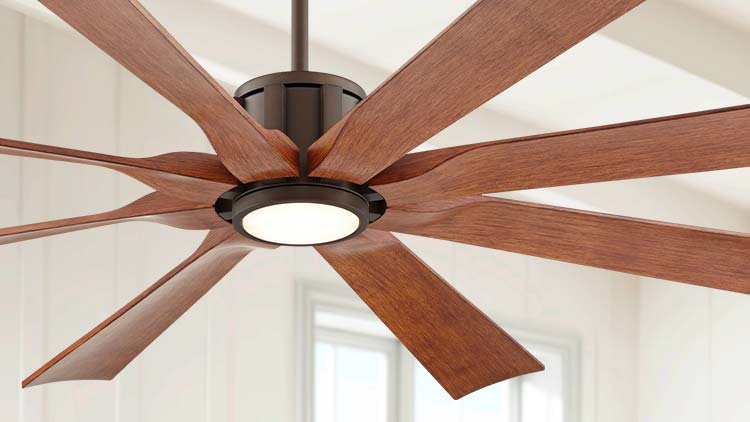
How to find the perfect ceiling fan for your space and budget
An easy, breezy guide to built-in fans.
How do ceiling fans work?
Ceiling fans don't actually lower the room temperature, but instead work the same way a breeze does: by moving air around and over your skin, which cools you by accelerating perspiration evaporation.
They can be an effective, low-cost alternative to air conditioners or even heaters during the cooler months.
Ceiling fan types
There are two broad categories of ceiling fans: alternating or direct current. Within these two categories are a number of alternatives that use different materials, sizes and blades.
Some include a built-in light which is useful if you want to install a fan but only has a single fitting in the roof.
Ceiling fans using an alternating current (AC) motor are the most common type you'll find in an existing installation. And they tend to be cheaper with a range of options under $200.
Fans using a direct current (DC) motor are becoming more common and deliver even greater efficiency, lowering running costs.
Speed options with DC models also allow more control over air movement – up to seven settings – compared to most AC models, which have only three settings.
The DC motor has an internal inverter and is therefore compatible with normal AC electrical systems, so you don't need to do anything special to install a DC ceiling fan in a home. In fact, a DC-powered ceiling fan can't be connected directly to a DC power source.
How to save energy with year-round use
Your fan can pull double duty and keep your home comfortable in winter by bringing the heat down to the living area without creating an uncomfortable warm draught.
Reversing the direction of the fan, from anticlockwise in summer to clockwise in winter, draws air upwards rather than downwards, moving warm air around in winter without creating a downward breeze in the room.
This is useful on its own or when used together with a heater or reverse-cycle air conditioner.
DC fans deliver up to seven speeds including reverse. But even if your fan can't go in reverse, you may find one of the slowest normal speeds works well for you in winter by driving warm air down from the ceiling without creating a significant draught effect.
Optimise your home's efficiency
Specifying ceiling fans in all rooms will not only help you meet the latest National Construction Code, it's also required for the top rating (7 stars). Under the Nationwide House Energy Rating Scheme (NatHERS) rating, including more ceiling fans will also improve your comfort in summer and winter.
Finding the right size fan for your room
The first thing you need to figure out is the size of your room and your preferred operating speed range. If these don't match up, the fan won't suit your requirements.
Your best option is to measure your room, record the dimensions, then take them to the retailer or manufacturer's website. Most provide a sizing chart that recommends optimal models based on the size of your room.
A 52-inch (132cm) fan is considered the standard size, and if it has more than three speeds, it should deliver the air movement you need for a comfortable night's sleep without blowing your bed sheets off.
Ceiling fans can keep your home comfortable in winter by bringing the heat down to the living area
If your room is on the smaller side, then a 48-inch (122cm) fan will be a better choice. The smaller size may also give you a better chance of getting the air movement you want, even if you select a three-speed model.
Larger fans over 54 inches (137cm) are better for larger square rooms, around the 5x5m mark or bigger. Not only can they move air around the entire room, but their proportions are also appropriate to the space, so they'll look good too.
However, long open areas that are more of a rectangular shape will benefit from multiple 52-inch models, as they can deliver a more consistent airflow throughout the area. In any case, you'll likely run large fans like these at their lowest speed most of the time.
Does ceiling height make a difference?
Absolutely! The minimum ceiling height needs to be between 2.1–2.4m for the best performance.
If your ceiling is significantly higher, around 2.7–3m or more, you'll most likely need an extension rod to lower the fan to an optimal level. These are often included or available for an additional fee, though not with every model, so double-check before you buy.

